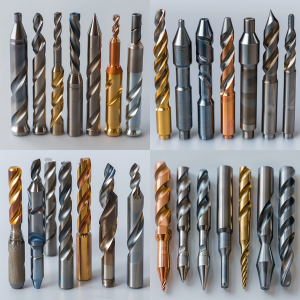Technical Features and Advantages of Cemented Carbide Tools
Cemented carbide tools (карбидные инструменты, alat karbida) are renowned for their superior performance and durability. This article explores the technical features that make these tools a preferred choice in various industries.
Composition and Manufacturing Process
Cemented carbide tools are composed primarily of tungsten carbide (WC) and cobalt (Co). Tungsten carbide, which is a compound of tungsten and carbon, provides the hardness and wear resistance, while cobalt acts as a binder to hold the tungsten carbide particles together, giving the tool its toughness.
The manufacturing process involves several key steps:
- Powder Preparation: Tungsten carbide powder is mixed with cobalt powder in specific proportions to achieve the desired properties.
- Pressing: The mixed powder is pressed into the desired shape using a high-pressure press.
- Sintering: The pressed shape is heated in a sintering furnace at temperatures between 1400°C and 1600°C. This process causes the cobalt to melt and bond the tungsten carbide particles together, resulting in a dense and hard structure.
Advanced manufacturing techniques, such as hot isostatic pressing (HIP), can further enhance the properties of the carbide tools by eliminating any remaining porosity and improving the uniformity of the material.
Advantages Over Traditional Tools
Cemented carbide tools offer several significant advantages over traditional high-speed steel (HSS) and other cutting tools:
- Wear Resistance: Cemented carbide tools provide exceptional wear resistance, significantly outperforming traditional tools. This is due to the hardness of tungsten carbide, which makes these tools less susceptible to abrasive wear. For example, cemented carbide tools can maintain their cutting edge much longer than HSS tools, resulting in fewer tool changes and higher productivity.
- Hardness and Strength: Tungsten carbide has a hardness of approximately 1600 HV (Vickers hardness), which is significantly higher than that of high-speed steel, which typically ranges from 600 to 900 HV. This high hardness allows cemented carbide tools to cut through tough materials with ease. Furthermore, the toughness provided by the cobalt binder helps the tool withstand impact and mechanical shock, making it suitable for heavy-duty applications.
- Cost-Effectiveness: Despite the higher initial cost, cemented carbide tools are more cost-effective in the long run due to their extended lifespan and superior performance. They require fewer replacements and less downtime, leading to increased operational efficiency and reduced overall tooling costs.
- High-Speed Machining Capability: Cemented carbide tools can operate at higher cutting speeds than traditional tools, which translates to faster machining times and increased production rates. This capability is particularly important in high-volume manufacturing environments where time and efficiency are critical.
- Thermal Stability: Cemented carbide tools maintain their hardness and cutting performance at higher temperatures, which is beneficial when machining high-temperature alloys or performing operations that generate significant heat. This thermal stability helps prevent tool deformation and failure under extreme conditions.
Data and Industry Insights
Recent studies and market reports highlight the growing adoption of cemented carbide tools across various industries. According to a report by MarketsandMarkets, the global cemented carbide tools market is projected to reach USD 10.36 billion by 2026, growing at a CAGR of 6.5% from 2021 to 2026. This growth is driven by the increasing demand for high-performance cutting tools in industries such as automotive, aerospace, and electronics.
Furthermore, a technical study published in the International Journal of Advanced Manufacturing Technology found that the wear resistance of cemented carbide tools is up to 10 times higher than that of traditional HSS tools, leading to significantly improved tool life and machining efficiency.
Conclusion
In summary, cemented carbide tools offer numerous advantages over traditional cutting tools, including superior wear resistance, hardness, strength, cost-effectiveness, high-speed machining capability, and thermal stability. These features make them an indispensable choice for modern manufacturing processes that demand high performance and reliability.
In our next article, we will discuss the performance of cemented carbide tools in different application fields, such as turning tools (токарные инструменты, alat bubut).
Post time: Jun-11-2024

